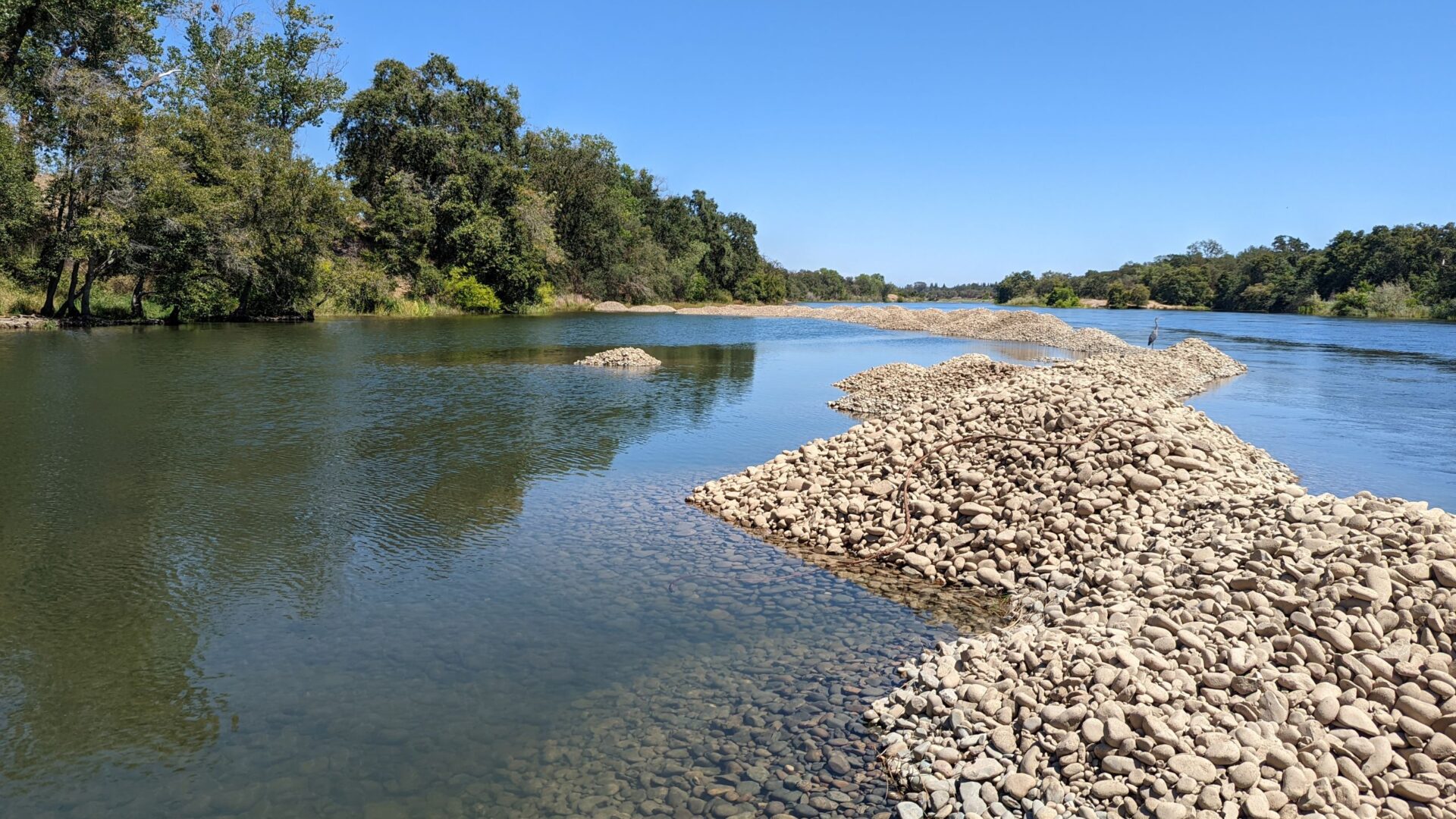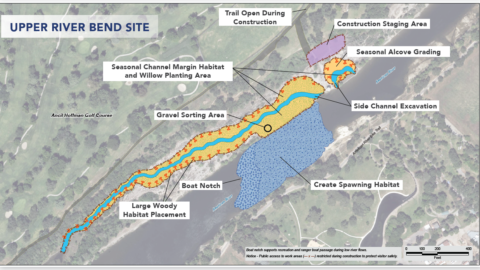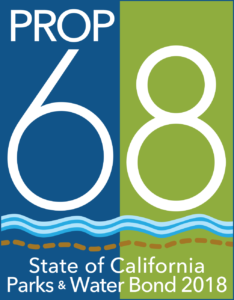Project Overview
Each year, the Water Forum works to create and enhance habitat for native fall-run Chinook salmon and steelhead trout. Both species migrate to the Lower American River as adults to spawn. Fall-run Chinook salmon generally spawn from October through December and steelhead trout spawning generally occurs January through March. In the egg laying process, female salmonids create a “nest” (called a redd) in loose gravel in flowing water, deposit their eggs, and then cover them with more gravel. Once hatched, young fish move to the river’s slower moving floodplain and side channel areas to find protection from predators and grow before swimming out to the Pacific Ocean.
The Water Forum’s 2023 Habitat Project is enhancing crucial habitat for native fall-run Chinook salmon and steelhead trout at Upper River Bend (in the river at Ancil Hoffman Park past the public golf course parking lot on Tarshes Drive).
The project is providing:
- Nearly 5 acres of spawning habitat for adult salmon and steelhead to create redds (underwater depressions or “nests”), constructed by placing 30,000 cubic yards of clean gravel into the flowing river.
- Nearly 6 acres of rearing habitat for young fish to hide from predators, find food and grow, created by carving a 2,000-foot side channel into the existing gr avel bar and shaping 3.7 acres of seasonal channel margin habitat.
- Hiding and resting places for young fish by placing about 60 large woody tree structures into the side channel.
- Over 3 acres of enhanced riparian landscape by planting or seeding the project area with willows or native flowers and grasses after construction.
In-river work is scheduled to finish no later than October 31, before anadromous Chinook salmon return in high numbers from the Pacific Ocean to the Lower American River.
Crews may be on site Monday through Saturday from 6 a.m. to 6 p.m. (noise starting at 7 a.m.) with in-river work occurring only on weekdays.
- Upper River Bend Habitat Project Reaches Halfway Milestone
- View the recording of the Project Virtual Information Session
- Read the 2023 Habitat Project fact sheet
- Read the 2023 Habitat Project mailer for local residents
- Update on results of the 2021 Habitat Project at Ancil Hoffman Park Near the Effie Yeaw Nature Center
Frequently Asked Questions
Why Upper River Bend?
Habitat is limited: Each year, thousands of native salmon and steelhead adults use the Delta and Sacramento River like a highway to move to their native spawning areas in the Lower American River. Historically, they utilized over 100 miles of mainstem and upper watershed habitat before Folsom and Nimbus dams blocked their passage. Dams also trap vital sediment needed to replenish spawning areas that naturally erode over time in our dynamic river. The Water Forum identifies areas like Upper River Bend at Ancil Hoffman Park to replenish gravel to help stay ahead of these processes and support the fishery. In spring, newly hatched young fish use the same corridor to outmigrate.
Habitat projects produce measurable results: The 2021 habitat project at Ancil Hoffman Park near the Effie Yeaw Nature Center produced a noticeable surge in salmon redds—from just 64 Chinook redds at the site in fall 2020 to more than double just a few months after project construction.
What can residents and park visitors expect?
- Noise: Most of the noise is expected to come from machinery that washes and sorts gravel before it is placed into the river. The project team contains this noise to the hours of 7 a.m. to 6 p.m. Monday-Saturday.
- Gravel hauling and tree delivery traffic: The project will source gravel from onsite and haul excess material out of the park for use in other areas of the American River Parkway. The project will also reuse decommissioned orchard trees for woody habitat that will be delivered to the site. Hauling traffic is expected to take place Monday through Saturday over a 22-day period with one to three trips per hour. Trucks will travel via Tarshes Drive, south onto California Avenue and west onto Van Alstine Ave.
- Access to the walking trail: The walking trail circling the golf course and along the river will remain open with fencing and signage to direct the public around construction areas and potential hazards.
- Access to Ancil Hoffman Golf Course: The project is not expected to impact access to the golf course.
- Access to the river: During construction, access to the river from the shore will be blocked to the public within the construction areas. During off-work hours, construction areas and equipment will be secured with fencing and on-site security. The public will have access to the river along the shore in any areas where it is safe.
- Parking: Public parking is not expected to be impacted.
- Employee traffic: The project team includes about a dozen employees who will travel to and from the project site twice daily (at the beginning and end of the day) via Tarshes Drive.
- Equipment traffic: The project will use heavy equipment to excavate, move, wash and place gravel into the river, as well as create a side channel. This equipment includes large bulldozers, excavators, front loaders and trucks. The equipment will move into and out of Ancil Hoffman Park at the beginning and end of the project.
How is the project expected to impact rafters?
The project team is working to minimize impacts on rafters moving through the Ancil Hoffman area. In-river construction will take place during weekdays only (and not on Labor Day). Signage will be placed at popular upriver entrance points to alert boaters of the work occurring downstream. When in-river work is occurring, the project team will be on alert and communicating with equipment operators to allow for safe passage through the construction site.
Is the Water Forum’s work in the Lower American River a mining operation?
No, it’s actually the opposite.
River dredging was once a significant part of mining operations on the Lower American River from the gold rush through the 1940s. Dredging involved the use of large machines equipped with buckets to remove riverbed materials and a long conveyor for dumping the tailings (gravel and gold-bearing sediments) at the rear of the machine. Gravel was sorted by screens, which left the gold for collection. The rocks deposited behind the screens created tailings piles that can still be seen along the river.
Water Forum Habitat Projects seek to return some of the gravel historically removed from the river with dredging to provide places for salmon and steelhead to create redds (nests). Salmonids need a specific size of gravel, no larger than the size of a fist, to create redds. As part of the habitat enhancement process, gravel is excavated from high areas along the river, and cleaned and sorted into this optimum size. Teams then strategically place the clean gravel into the flowing river according to design plans.
Importantly, the Water Forum projects have undergone an environmental analysis as required by California Environmental Quality Act (CEQA) and National Environmental Policy Act (NEPA) and have acquired all applicable permits and approvals from natural resource and public safety agencies. You can find environmental documentation at https://waterforum.org/habitat-enhancement.
About the Water Forum, Funding and Project Partners
This is the Water Forum’s 13th project enhancing fish spawning and rearing habitat on the Lower American River since 2008.
The 2023 Habitat Project is made possible by grant funding from the California Natural Resources Agency (Proposition 68) and the Central Valley Project Improvement Act (U.S. Bureau of Reclamation).
Project partners include:
- The Water Forum brings together a diverse group of environmental and citizen groups, business leaders, water agencies and local governments working together to balance water supply needs with protection of the Lower American River.
- The U.S. Bureau of Reclamation funds habitat restoration projects through the Central Valley Project Improvement Act (CVPIA).
- The U.S. Fish and Wildlife Service implements the CVPIA with Reclamation and funds monitoring of Water Forum habitat projects.
- The California Department of Fish and Wildlife conducts salmon monitoring on the river.
- Sacramento County Regional Parks, as the landowner, hosts all of the restoration projects within the American River Parkway, and provides input and guidance regarding compliance with their Natural Resources Management Plan.
- The Sacramento Area Flood Control Agency (SAFCA) provides vital permitting support so the U.S. Army Corp of Engineers can ensure projects are designed to avoid increasing flood risk to the area and other environmental requirements are met.




